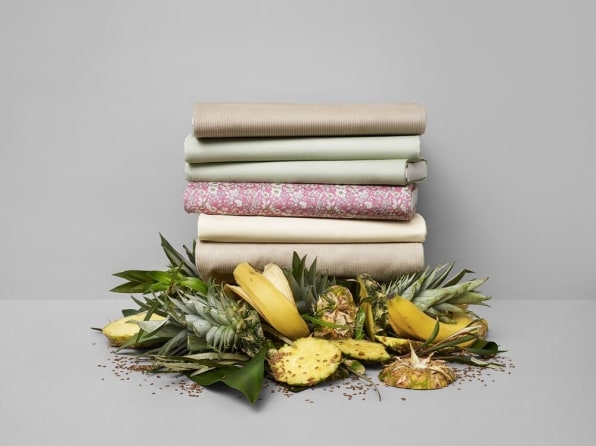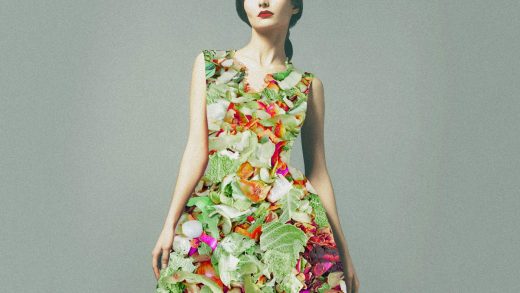Food waste is going to take over the fashion industry
Around the world, people eat around 100 billion bananas every year. That creates around 270 million tons of waste–from peels to stalks–which are often burned or left to rot. Crop burning pollutes the air, and rotting releases methane into the atmosphere and contributes to global warming.
Isaac Nichelson, a three-decade veteran of the sustainable fashion industry, learned of the magnitude of this waste and saw an opportunity. Food crop waste like banana by-products, pineapple leaves, flax and hemp stalk, and the waste from crushing sugar cane can be collected and spun into a natural fiber that can be woven into garments. While this concept is progressive, it’s really a reversion to the past–as recently as 1960, 97% of the fibers we used in garments and materials were naturally derived. Today, it’s only around 35%.
Through his new materials startup Circular Systems, which converts these natural waste fibers into usable materials, Nichelson wants to set the fashion industry on a new path toward more sustainable production and sourcing. Circular Systems was recently awarded a $350,000 Global Change Award grant from the H&M Foundation to scale up its operations, and it has partnerships in the works with global brands like H&M and Levis to integrate its sustainable fibers into their operations.
Circular Systems comprises three technologies. There’s the Agraloop Bio-Refinery, a proprietary system that transforms crop waste into textiles. The same farmers and producers who harvest the crops can own and use Agraloop systems to create additional revenue for themselves, and put their excess waste to use. “We want to enable food crops to become our primary fibers,” Nichelson says. Just those five key waste products, he adds, offer around 250 million tons of fiber each year, and could meet 2.5 times the global demand for fiber currently.

The second technology, Texloop, converts textile scraps and used clothing into new fibers. Around 16% of all textiles end up scrapped on cutting-room floors, and 85% of used clothing ends up in landfills, and Texloop uses a proprietary technology to blend a variety of natural and synthetic textiles into new threads and fabrics. Circular Systems has also developed technology called Orbital, which spins both food crop waste fibers and textile waste fibers together into a new yarn product that’s both durable and moisture wicking. While patents and partnerships for Orbital are still in the works, Nichelson says there’s been interest in the product from major sportswear brands.
Nichelson’s interest in creating more sustainable textiles dates back to when he was working as a surf wear and outerwear designer in the 1990s and witnessing how heavily the production process leaned on chemicals. One day, when he walked into his company’s production facility in Portland, Oregon, he almost passed out from the fumes. “I couldn’t believe that people were going to be in there working in these conditions,” Nichelson says. Nichelson became interested in developing more natural materials that achieved the same high-performance effects of chemical-based fabrics like nylon and polyester.
That search led Nichelson to meet Yitzac Goldstein, a materials scientist who had created a range of materials from recycled fibers and Geof Kime, who in the 1990s successfully pushed to get industrial hemp legalized in Canada so it could be grown as a more sustainable alternative to synthetic materials. While the three have been collaborating for the past two decades around how to bring the ideas of regenerative agriculture and sustainable textile production to the fashion industry at scale, it wasn’t until last year that they launched Circular Systems in order to do so.
“The time was really right,” Nichelson says. “We made some breakthroughs in our technologies recently, and there was also a breakthrough in the market.” Plentiful data now exists to back up the need for the fashion industry to move away from chemical production and waste, and toward more sustainable and less extractive means of sourcing and manufacturing. We’re now seeing, for instance, ocean-bound plastic waste being transformed into wearable shoes, and leather being replaced with more sustainable alternatives grown from fermented collagen and mushroom roots.
Making this shift to more sustainable materials is also essential for the fashion industry from an economic standpoint, Nichelson adds. Each year, McKinsey and Company and Business of Fashion release an annual survey of the industry, and this year, the report forecasted that the fashion industry will see losses of 3% to 4% across the board unless companies can rethink their supply chains to provide for more resource efficiency and less waste. “Right now, it’s so extractive and so destructive, and we’re looking at these resources becoming more and more finite as the population grows,” Nichelson says. And as the population grows, it’s crucial that farmable land be used to grow food, not textile crops like cotton. “If there’s not collective and very swift action, it’s going to be catastrophic for the industry from an economic standpoint,” Nichelson says.
So now, all the fashion industry leaders–who in the past, may have stymied sustainability efforts in favor of cutting costs–“are now our new best friends,” Nichelson says. While sustainable sourcing is necessarily more expensive and slower, it’s the direction the industry should be heading in, Nichelson says–and then end goal should ultimately be to produce less, and abandon growth as an indicator of success. “All of our industries need to be retrofitted for real sustainability and become regenerative by nature, and it will be better for business.”
(24)



